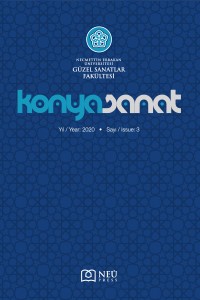Abstract
Keywords
References
- Bağcı S. (1993). Takdim Minyatürlerinde Farklı Bir Konu: Süleyman Peygamber Divanı, Sanat Tarihinde İkonografik Araştırmalar Güner İnal’a Armağan (s. 35-59), Ankara: Hacettepe Üniversitesi Yayınları.
- Baysal, A. F. (2010). Mushaf Tezyinatının Tarihi İçindeki Gelişimi, Marife, 10 (3), Konya 2010, 365-386.
- Çağman, F. ve Tanındı, Z. (1979) Topkapı sarayı Müzesi İslam Minyatürleri, İstanbul: Tercüman Kültür ve Sanat Yayınları.
- Çağman, F. ve Tanındı, Z. (2002), Manuscript Production at the Kâzarûnî Orders in Safavid Shiraz, S.R. Canby (Ed.), Safavid Art & Architecture (s.43-48), London: Cambridge University Press.
- İnal, G. (1995). Türk Minyatür Sanatı (Başlangıcından Osmanlılara Kadar), Ankara: Atatürk Kültür Merkezi Yayınları.
- Robinson, B.W. (1967). Persian Miniature Painting from Collections in The British Isles. London: Her Majesty’s Stationery Office.
- Robinson, B.W. (1979). Painter-Illuminators of Sixteenth-Century Shiraz, Journal of the British Institute of Persian Studies, 17, 105-108.
- Uluç, L. (2006), Türkmen Valiler Şirazlı Ustalar Osmanlı Okurlar XVI. Yüzyıl Şiraz Elyazmaları, İstanbul: Türkiye İş Bankası Kültür Yayınları.
- Uluç, L. (2014). Zülkadirli Şiraz Valilerin Son Döneminden Resimli Bir Yusuf ve Züleyha Nüshası, B. Tanman (Ed.), Nurhan Atasoy’a Armağan (s.386-421) İstanbul: Lale Yayıncılık.
- Wright, E. (2013). The Look of the Book Manuscript Production in Shiraz 1303-1452. Washington DC: University of Washington Press.
Abstract
The Safavid state founded by Shah Ismail in 1501 in today's Iranian lands, was built deep rooted cultural and artistic accumulation of the previous Timurids and Turkmens civilization. In the first years of the state, many illuminated works were prepared that bearing the traces of these civilizations. Under the Safavid administration, which had a culturally distinctive state structure in a short time, important manuscripts were produced in Tabriz, Kazvin, Herat, Isfahan and Khorasan, especially in Shiraz, the center of the Fars region. Shiraz city, XVI. throughout the century, has been a provincial center where high quality manuscripts were produced except the capital. The illuminated manuscripts prepared using rich materials in Shiraz book arts mostly consist of literary and historical copies and the Qur’an. Some of these manuscripts were distributed or conveyed to many cities, especially Istanbul, the capital city of the Ottoman Empire, for various reasons at that time. Copies of one of the Persian classics, Hamse-i Nizamî, produced in the Shiraz atelier of the period, were especially sought after as a gift by Ottoman bureaucrats in Istanbul. The number of Hamse-i Nizâmî manuscripts that’s known to be produced in Shiraz is highly much in the Topkapı Palace Museum Library. The illumination features of the Hamse-i Nizamî copy with inventory number 758, which is in the Treasury Archive of the Topkapı Palace Museum Library, constitute the essence of our study.
Keywords
References
- Bağcı S. (1993). Takdim Minyatürlerinde Farklı Bir Konu: Süleyman Peygamber Divanı, Sanat Tarihinde İkonografik Araştırmalar Güner İnal’a Armağan (s. 35-59), Ankara: Hacettepe Üniversitesi Yayınları.
- Baysal, A. F. (2010). Mushaf Tezyinatının Tarihi İçindeki Gelişimi, Marife, 10 (3), Konya 2010, 365-386.
- Çağman, F. ve Tanındı, Z. (1979) Topkapı sarayı Müzesi İslam Minyatürleri, İstanbul: Tercüman Kültür ve Sanat Yayınları.
- Çağman, F. ve Tanındı, Z. (2002), Manuscript Production at the Kâzarûnî Orders in Safavid Shiraz, S.R. Canby (Ed.), Safavid Art & Architecture (s.43-48), London: Cambridge University Press.
- İnal, G. (1995). Türk Minyatür Sanatı (Başlangıcından Osmanlılara Kadar), Ankara: Atatürk Kültür Merkezi Yayınları.
- Robinson, B.W. (1967). Persian Miniature Painting from Collections in The British Isles. London: Her Majesty’s Stationery Office.
- Robinson, B.W. (1979). Painter-Illuminators of Sixteenth-Century Shiraz, Journal of the British Institute of Persian Studies, 17, 105-108.
- Uluç, L. (2006), Türkmen Valiler Şirazlı Ustalar Osmanlı Okurlar XVI. Yüzyıl Şiraz Elyazmaları, İstanbul: Türkiye İş Bankası Kültür Yayınları.
- Uluç, L. (2014). Zülkadirli Şiraz Valilerin Son Döneminden Resimli Bir Yusuf ve Züleyha Nüshası, B. Tanman (Ed.), Nurhan Atasoy’a Armağan (s.386-421) İstanbul: Lale Yayıncılık.
- Wright, E. (2013). The Look of the Book Manuscript Production in Shiraz 1303-1452. Washington DC: University of Washington Press.
Details
| Primary Language | Turkish |
|---|---|
| Journal Section | Research Articles |
| Authors | |
| Publication Date | December 25, 2020 |
| Submission Date | October 16, 2020 |
| Published in Issue | Year 2020 Issue: 3 |


